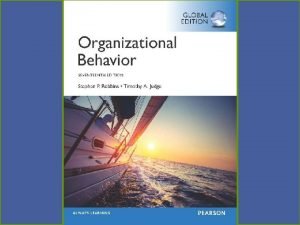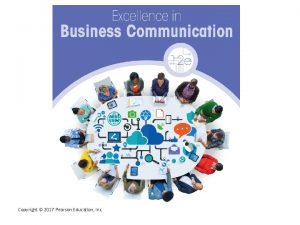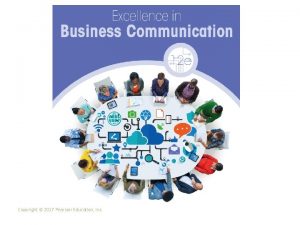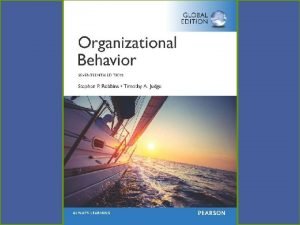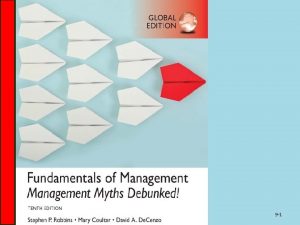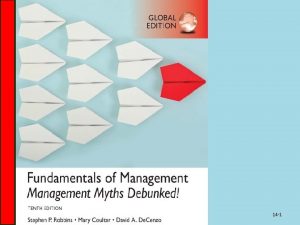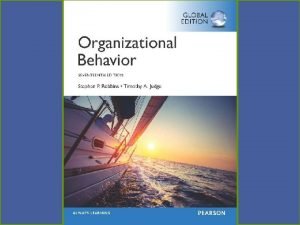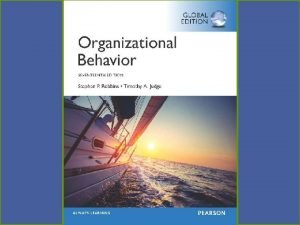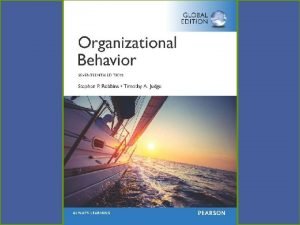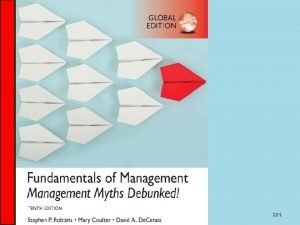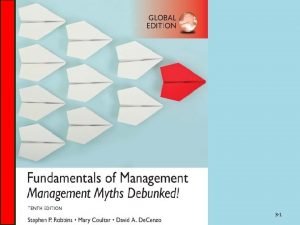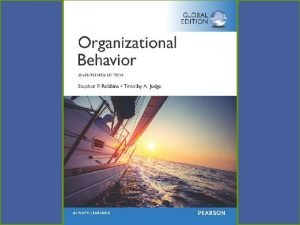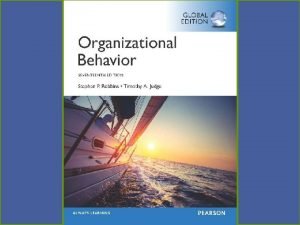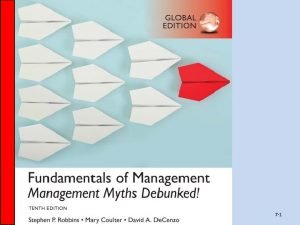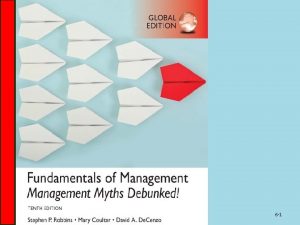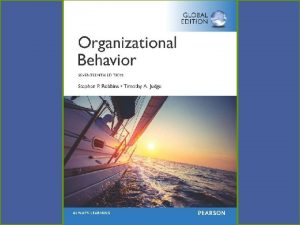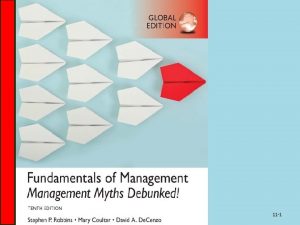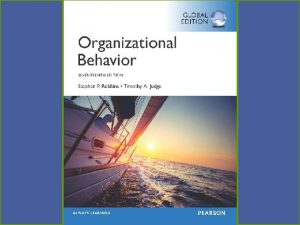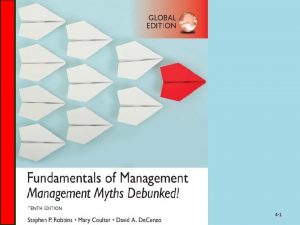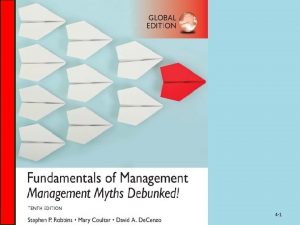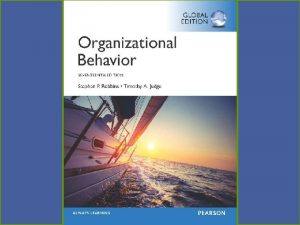Copyright 2017 Pearson Education Ltd 1 1 5



























- Slides: 27

Copyright © 2017 Pearson Education, Ltd. 1 -1

5 Personality and Values Copyright © 2017 Pearson Education, Ltd.

Learning Objectives q Describe personality, the way it is measured, and the factors that shape it. q Describe the strengths and weaknesses of the Myers-Briggs Type Indicator (MBTI) personality framework and the Big Five model. q Discuss how the concepts of core self-evaluation (CSE), selfmonitoring, and proactive personality contribute to the understanding of personality. q Describe how the situation affects whether personality predicts behavior. q Contrast terminal and instrumental values. q Describe the differences between person-job fit and personorganization fit. q Compare Hofstede’s five value dimensions and the GLOBE Copyright © 2017 Pearson Education, Ltd. framework. 5 -3

LO 1 Describe Personality, the Way It Is Measured, and the Factors that Shape It ØDefining Personality Ø Personality is a dynamic concept describing the growth and development of a person’s whole psychological system. Ø The sum total of ways in which an individual reacts to and interacts with others. Copyright © 2017 Pearson Education, Ltd. 5 -4

LO 1 Describe Personality, the Way It Is Measured, and the Factors that Shape It ØMeasuring Personality Ø Managers need to know how to measure personality. ØPersonality tests are useful in hiring decisions and help managers forecast who is best for a job. Ø The most common means of measuring personality is through self-report surveys. Copyright © 2017 Pearson Education, Ltd. 5 -5

LO 1 Describe Personality, the Way It Is Measured, and the Factors that Shape It ØPersonality Determinants Ø Is personality the result of heredity or environment? Ø Heredity refers to those factors that were determined at conception. Ø The heredity approach argues that the ultimate explanation of an individual’s personality is the molecular structure of the genes, located in the chromosomes. Copyright © 2017 Pearson Education, Ltd. 5 -6

LO 1 Describe Personality, the Way It Is Measured, and the Factors that Shape It ØEarly research tried to identify and label enduring personality characteristics. Ø Shy, aggressive, submissive, lazy, ambitious, loyal, and timid. ØThese are personality traits. Copyright © 2017 Pearson Education, Ltd. 5 -7

LO 2 Strengths and Weakness of the MBTI and Big Five Model ØThe most widely used personality framework is the Myers-Briggs Type Indicator (MBTI). ØIndividuals are classified as: Ø Extroverted or Introverted (E or I) Ø Sensing or Intuitive (S or N) Ø Thinking or Feeling (T or F) Ø Perceiving or Judging (P or J) ØINTJs are visionaries. ØESTJs are organizers. ØENTPs are conceptualizers. Copyright © 2017 Pearson Education, Ltd. 5 -8

LO 2 Strengths and Weakness of the MBTI and Big Five Model ØThe Big Five Model Ø Extraversion Ø Agreeableness Ø Conscientiousness Ø Emotional stability Ø Openness to experience Copyright © 2017 Pearson Education, Ltd. 5 -9

LO 2 Strengths and Weakness of the MBTI and Big Five Model Copyright © 2017 Pearson Education, Ltd. 5 -10

LO 2 Strengths and Weakness of the MBTI and Big Five Model Copyright © 2017 Pearson Education, Ltd. 5 -11

LO 2 Strengths and Weakness of the MBTI and Big Five Model ØThe Dark Triad Machiavellianism: the degree to which an individual is pragmatic, maintains emotional distance, and believes that ends can justify means. Narcissism: the tendency to be arrogant, have a grandiose sense of self-importance, require excessive admiration, and have a sense of entitlement. Psychopathy: the tendency for a lack of concern for others and a lack of guilt or remorse when their actions cause harm. Copyright © 2017 Pearson Education, Ltd. 5 -12

LO 2 Strengths and Weakness of the MBTI and Big Five Model ØAn emerging framework to study dark side traits: Ø First, antisocial people are indifferent and callous toward others. Ø Second, borderline people have low selfesteem and high uncertainty. Copyright © 2017 Pearson Education, Ltd. 5 -13

LO 2 Strengths and Weakness of the MBTI and Big Five Model Ø Third, schizotypal individuals are eccentric and disorganized. Ø Fourth, obsessive compulsive people are perfectionists and can be stubborn, yet they attend to details, carry a strong work ethic, and may be motivated by achievement. Ø Fifth, avoidant individuals feel inadequate and hate criticism. Copyright © 2017 Pearson Education, Ltd. 5 -14

LO 3 CSE, Self-Monitoring, and Proactive Personality ØOther Personality Traits Relevant to OB Ø Core Self-Evaluation: bottom line conclusions individuals have about their capabilities, competence, and worth as a person. Ø Self-Monitoring: measures an individual’s ability to adjust his or her behavior to external, situational factors. Ø Proactive Personality: people who identify opportunities, show initiative, take action, and persevere until meaningful change occurs. Copyright © 2017 Pearson Education, Ltd. 5 -15

LO 4 The Situation, Personality, and Behavior ØSituation strength theory: indicates that the way personality translates into behavior depends on the strength of the situation. Ø The degree to which norms, cues, or standards dictate appropriate behavior. ØClarity ØConsistency ØConstraints ØConsequences Copyright © 2017 Pearson Education, Ltd. 5 -16

LO 4 The Situation, Personality, and Behavior Copyright © 2017 Pearson Education, Ltd. 5 -17

LO 5 Contrast Terminal and Instrumental Values ØValues: basic convictions about what is right, good, or desirable. Ø Value system: ranks values in terms of intensity. ØThe Importance and Organization of Values Ø Values: ØLay the foundation for understanding of attitudes and motivation. ØInfluence attitudes and behaviors. Copyright © 2017 Pearson Education, Ltd. 5 -18

LO 5 Contrast Terminal and Instrumental Values ØTerminal vs. Instrumental Values Ø Terminal values: desirable end-states of existence. Ø Instrumental values: preferred modes of behavior or means of achieving terminal values. Copyright © 2017 Pearson Education, Ltd. 5 -19

LO 5 Contrast Terminal and Instrumental Values Copyright © 2017 Pearson Education, Ltd. 5 -20

LO 6 Person-Job Fit vs. Person-Organization Fit Copyright © 2017 Pearson Education, Ltd. 5 -21

LO 6 Person-Job Fit vs. Person-Organization Fit Ø People high on extraversion fit well with aggressive and team-oriented cultures. Ø People high on agreeableness match up better with a supportive organizational climate than one focused on aggressiveness. Ø People high on openness to experience fit better in organizations that emphasize innovation rather than standardization. Copyright © 2017 Pearson Education, Ltd. 5 -22

LO 6 Person-Job Fit vs. Person-Organization Fit ØOther Dimensions of Fit ØAlthough person-job fit and person-organization fit are considered the most salient dimensions for workplace outcomes, other avenues of fit are worth examining. ØPerson-group fit ØPerson-supervisor fit Copyright © 2017 Pearson Education, Ltd. 5 -23

LO 7 Hofstede’s Five Value Dimensions and GLOBE ØHofstede’s Framework Ø Power distance Ø Individualism versus collectivism Ø Masculinity versus femininity Ø Uncertainty avoidance Ø Long-term versus short-term orientation Copyright © 2017 Pearson Education, Ltd. 5 -24

LO 7 Hofstede’s Five Value Dimensions and GLOBE ØThe GLOBE Framework for Assessing Culture Ø The Global Leadership and Organizational Behavior Effectiveness (GLOBE) research program updated Hofstede’s research. ØData from 825 organizations and 62 countries. ØUsed variables similar to Hofstede’s. ØAdded some news ones. Copyright © 2017 Pearson Education, Ltd. 5 -25

Implications for Managers ØConsider screening job candidates for high conscientiousness—as well as the other Big Five traits—depending on the criteria your organization finds most important. Other aspects, such as core self-evaluation or narcissism, may be relevant in certain situations. ØAlthough the MBTI has faults, you can use it for training and development; to help employees better understand each other, open up communication in work groups, and possibly reduce conflicts. Copyright © 2017 Pearson Education, Ltd. 5 -26

Implications for Managers ØEvaluate jobs, work groups, and your organization to determine the optimal personality fit. ØTake into account employees' situational factors when evaluating their observable personality traits, and lower the situation strength, to better ascertain personality characteristics. ØThe more you consider people’s different cultures, the better you will be able to determine their work behavior and create a positive organizational climate that performs well. Copyright © 2017 Pearson Education, Ltd. 5 -27
 Pearson education limited 2017
Pearson education limited 2017 Pearson education ltd
Pearson education ltd Pearson education ltd 2017
Pearson education ltd 2017 Copyright pearson education inc
Copyright pearson education inc Copyright 2010 pearson education inc
Copyright 2010 pearson education inc Copyright 2009
Copyright 2009 2018 pearson education inc
2018 pearson education inc 2014 pearson education inc
2014 pearson education inc Copyright 2010 pearson education inc
Copyright 2010 pearson education inc Copyright 2010 pearson education inc
Copyright 2010 pearson education inc Copyright by pearson education inc. answers
Copyright by pearson education inc. answers 2008 pearson education inc
2008 pearson education inc Copyright 2009 pearson education inc
Copyright 2009 pearson education inc Copyright pearson education inc
Copyright pearson education inc Copyright 2010 pearson education inc
Copyright 2010 pearson education inc Copyright 2010 pearson education inc
Copyright 2010 pearson education inc Copyright 2010 pearson education inc
Copyright 2010 pearson education inc 2010 pearson education inc
2010 pearson education inc Copyright 2010 pearson education inc
Copyright 2010 pearson education inc Composition copyright example
Composition copyright example Pearson education inc all rights reserved
Pearson education inc all rights reserved Copyright 2009 pearson education inc
Copyright 2009 pearson education inc 2009 pearson education inc
2009 pearson education inc 2009 pearson education inc
2009 pearson education inc 2009 pearson education inc
2009 pearson education inc Copyright pearson education inc
Copyright pearson education inc 2017 pearson education inc
2017 pearson education inc 2017 pearson education inc
2017 pearson education inc
